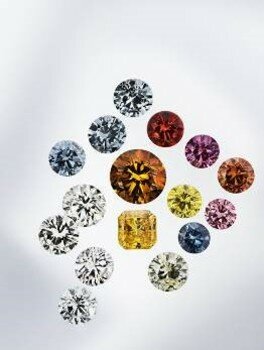 The fall issue of Gems & Gemology, GIA’s (Gemological Institute of America’s) quarterly professional journal, is available in print by subscription and in the GIA Store, and digitally – at no cost – on GIA.edu. The six articles featured in this issue cover HPHT synthetic diamonds, historical saltwater pearls from the New World, the photoluminescenc spectra of emeralds, synthetic star corundum and the Colombian emerald industry from mine to market.
The fall issue of Gems & Gemology, GIA’s (Gemological Institute of America’s) quarterly professional journal, is available in print by subscription and in the GIA Store, and digitally – at no cost – on GIA.edu. The six articles featured in this issue cover HPHT synthetic diamonds, historical saltwater pearls from the New World, the photoluminescenc spectra of emeralds, synthetic star corundum and the Colombian emerald industry from mine to market.The issue opens with “Observations on HPHT-Grown Synthetic Diamonds: A Review,” the first comprehensive summary published on a large sample of several thousand HPHT synthetic diamonds, all of which were examined by GIA from 2007 through 2016. GIA researchers Drs. Sally Eaton-Magaña, James Shigley and Christopher M. Breeding investigate trends in the distinctive features seen among HPHT synthetic diamonds from multiple sources over the past ten years.
In “Saltwater Pearls from the Pre- to Early Columbian Era: A Gemological and Radiocarbon Dating Study,” researchers at GIA and the Gübelin Gem Lab examine 85 natural saltwater pearls reportedly recovered from Caribbean waters to determine their origin and 14C isotope radiocarbon dating. The research team, led by GIA’s Chunhui Zhou, confirmed that the pearls originate from a Pinctada species.
The next article is “Photoluminescence Spectra of Emeralds from Colombia, Afghanistan, and Zambia.” Researchers led by Dr. D. Brian Thompson of the University of North Alabama investigated the PL spectra of 48 samples from these regions. Their research strongly indicates that variations in trace element concentration within emeralds from these localities correlate with their PL spectra, which could be very promising for determining the geographic source.
The fourth article, by Dr. Karl Schmetzer, Prof. H. Albert Gilg and Dr. Heinz-Jürgen Bernhardt, is “Synthetic Star Sapphires and Rubies Produced by Wiede’s Carbidwerk, Freyung, Germany.” These stones were grown using a variation of the Verneuil method followed by controlled annealing that exsolved the rutile needles, giving these cabochons a distinctive appearance.
“True Colors of ‘Dalmatian Jasper’” explores the details of this popular gemstone whose unique spots are similar to the coat of a Dalmatian. Tomasz Powolny and Dr. Magdalena Dumańska-Słowik determine that this stone’s composition and gemological characteristics do not meet the definition of jasper. Their recommended term is “Dalmatian stone.”
The last article, “The Colombian Emerald Industry: Winds of Change,” explores the history, geology and ongoing transformation of the Colombian emerald market. Darwin Fortaleché, chief gemologist at Colombia’s CDTEC lab, and his GIA coauthors provided this comprehensive field report.
G&G’s Lab Notes section features an entry on the separation of synthetic melee from natural diamond using GIA’s iD100 screening device. The Micro-World section includes hematite roses and a “flower-in-the-rain” inclusion within a Sri Lankan sapphire, while the Gem News International section spotlights blue-green pyrope-spessartine with high vanadium content and two potential new sources of Nigerian sapphire.
photo: The HPHT synthetic diamonds on the cover of Gems & Gemology, part of the GIA collection and ranging in weight from 0.31 to 1.94

